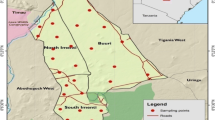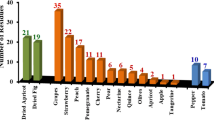Abstract
Farm worker and consumers are vulnerable to the potentially toxic pesticides accumulated in the environment and food. Nonetheless, few studies have investigated the pesticide pollution and risk in the medlar planting site at a large scale. Hereupon, this study focused on the pesticide contamination distribution, their potential risk assessment of contaminated sites and dietary. The 11 pesticide pollution sources were collected from the five systems of fruit, leaf, soil, groundwater, and honey based on a systematic review in medlar planting site. Seventy-six samples were analyzed by chromatography technique. Residues of 4 (36.7%) compounds were found in the samples. The most distributed pesticides were imidacloprid for all samples, followed by avermectin for leaf, soil, groundwater, and honey, and carbendazim for leaf, glyphosate for soil, and those with the highest average concentrations were carbendazim (3.8–8.4 mg/kg of leaf) and glyphosate (0.21–1.3 mg/kg of soil). The vertical migration characteristic of imidacloprid was relatively stable, and the residual concentration gradually declined with the increase of burial depth. However, glyphosate tended to accumulate gradually or was close to the surface concentration with the increase of burial depth. The distribution of abamectin had no obvious regularity. Imidacloprid was lower than the MRL in fruit and honey. Imidacloprid, avermectin, and glyphosate no MRL in soil and groundwater are set. Using the monitoring data, potential health risk come from fruit, soil, and groundwater was evaluated. The HI and HQ could be considered safe for pesticide residues in fruit, soil, and groundwater. Even if these results are in general safe to eat, the effects of insecticide on human health, especially on genetic toxicity, have gradually aroused more attention. To minimize the increasing human health risk, this study suggests that authorities must regulate the usage of agrochemicals, to strengthen the controls for effective implementation of the pesticide bans.








Similar content being viewed by others
Data availability
The datasets used and/or analyzed during the current study are available from the corresponding author on reasonable request.
References
Acton DF, Gregorich LJ (1995) The health of our soils. Available at: http://www.doc88.com/p- 1377102995347
Arcaute CR, Pérez-Iglesias M, Nikoloff N, Natale GS, Soloneski S, Larramendy ML (2014) Genotoxicity evaluation of the insecticide imidacloprid on circulating blood cells of Montevideo tree frog Hypsiboas pulchellus tadpoles (Anura, Hylidae) by comet and micronucleus bioassays. Ecol Indic 45:632–639. https://doi.org/10.1016/j.ecolind.2014.05.034
Arias EM, Lopez PE, Martinez CE (2008) Themobility and degradation of pesticides in soils and the pollution of groundwater resources. Agric Ecosyst Environ 123(4):247–260. https://doi.org/10.1016/j.agee.2007.07.011
Balakrishnan S, Rao P (2019) Biodegradation of chlorpyrifos by bacterial strains isolated from agricultural soils of Visakhapatnam District. J Bioremediat Biodegrad 10:2. https://doi.org/10.4172/2155-6199.1000459
Bivehed E, Gustafsson A, Berglund A, Hellman B (2020) Evaluation of potential DNA-damaging effects of nitenpyram and imidacloprid in human U937-cells using a new statistical approach to analyse comet data. Expo Health 12:547–554. https://doi.org/10.1007/s12403-019-00328-6
Chen X, Lu CX, Wang J (2016) Risk assessment of pesticide residues and heavymetal concentrations in wolfberry of Xinjiang. Farm Products Process 408(5):54–59. https://doi.org/10.16693/j.cnki.1671-9646(X).2016.05.044
European Commission (2014) Directive 2014/80/EU Amending Annex II to Directive 2006/ 118/EC of the European Parliament and of the Council on the Protection of Groundwater Against Pollution and Deterioration, OJ L182, pp 52–55
European Union (2020) EU Pesticides Database. Available at: http://ec.europa.eu/food/plant/pesticides/eu-pesticidesdatabase/public/?Event=homepage&language=EN. Accessed April 2020
Fu GP, Li GY, Ji Y, Wu ZF (2012) WHO Recommendations for public health pest control methods and pesticide dosage ranges. Pest Sci Admin 33(11):4–9. https://doi.org/10.3969/j.issn.1002-5480.2012.11.003
Gou CL, Zhang Y (2019) Ningxia Institute of Quality Standards and Testing Technology for Agricultural Products. Ningxia J Agric For Sci Technol 60(09):46–48. https://doi.org/10.3969/j.issn.1002-204x.2019.09.015
Guo WY, Li GH, Yang Q (2017) Progress in the Pesticides Residue of Honey. Food Res Dev 38(23):201–205. https://doi.org/10.3969/j.issn.1005-6521.2017.23.039
Guo L, Wang GG, Sheng YZ, Shi ZM, Sun XY (2019) Groundwater microbial communities and their connection to hydrochemical environment in Golmud, Northwest China. Sci Total Environ 695(2019):133848:1-11. https://doi.org/10.1016/j.scitotenv.2019.133848
Guo HB, Liu FX, Liu L, Ye JZ, Yang CL (2020a) Pesticide residue status and risk assessment of papaya in Guangdong and Guangxi area based on deterministic approach. Chin J Trop Crops Available at: https://kns.cnki.net/kcms/detail/46.1019.S.20200818. 1041.002
Guo JY, Shi R, Cao YY, Luan Y, Zhou YJ, Gao Y (2020b) Genotoxic effects of imidacloprid in human lymphoblastoid TK6 cells. Drug Chem Toxicol 43(2):208–212. https://doi.org/10.1080/01480545.2018.1497048
He J, Wang F, Hu RM (2016a) Integrated control techniques of main wolfberry diseases. Ningxia J Agric For Sci Technol 57(10):39–41 Available at: https://kns.cnki.net/kns8/defaulttresult/index
He J, Ren XH, Wang SJ (2016b) Study on migration and transformation of carbendazim. J Henan Agric Sci (10):80–84. https://doi.org/10.1593/j.cnki.1004-3268.2016.10.018
Lapworth DJ, Lopez B, Laabs V, Kozel R, Wolter R, Ward R, Vargas Amelin E, Besein T, Laessens J, Delloye F, Ferretti E (2018) Developing a groundwater watch list for substances of emerging concern: a European perspective. Environ Res Lett. https://doi.org/10.1088/748-9326/aaf4d7
Li ML (2017) Pesticide residues and their environmental pollution. Environ Dev 34(9):56–58 Available at: https://kns.cnki.net/kns8/defaulttresult/index
Li F (2019) Distribution and adsorption behavior of abamectin in rice environment. Jiangxi Agric Univ. https://doi.org/10.27177/d.cnki.gjxnu.2019.000149
Liu ZG, Liu BL, Wen HX, Tao YD, Shao Y (2020) Phytochemical profiles, nutritional constituents and antioxidant activity of black wolfberry(Lycium ruthenicum Murr). Ind Crop Prod 154(15). https://doi.org/10.1016/j.indcrop.2020.112692
Lu BL, Wu JH (2011) Analysis on pesticide residue in the soil of vegetables base in Jingzhou suburb. Hubei Agric Sci 50(9):1898–1900. https://doi.org/10.14088/j.cnki.issn0439-8114.2011.09.036
Mary M, Christian S, Al M, Jenny O, Richard L, Stéphanie Z, Jyotigna M (2020) An analysis of the setting of the acute reference dose (ARfD) for pesticides in Europe. Regul Toxicol Pharmacol 113. https://doi.org/10.1016/j.yrtph.2020.104638
Qiao H, Sun XF, Han Y (2017) Risk assessment of pesticide residue in wolfberry from Qaidam areas. Qual Saf Agro-products (5):38–43 Available at: https://kns.cnki.net /kns8/default tresult/ index
Rathod AL, Garg R (2017) Chlorpyrifos poisoning and its implications in human fatal cases: a forensic perspective with reference to Indian scenario. J Forensic Legal Med 47:29–34. https://doi.org/10.1016/j.jflflm.2017.02.003
Rial OR, Gonz LR, Guez RM, Cancho GB (2004) Parameters affecting extraction of selected fungicides from vineyard soils. J Agric Food Chem 52(24):7227–7234. https://doi.org/10.1021/jf0493019
Sheng Y, Yang SL, Han YX (2016) The concentration sand sources of nitrate in aerosol over Golmud, Qinhai, China. J Desert Search 3(36):792–793. https://doi.org/10.7522/j.issn.1000-694X.2015.00054
Tang LH, Ma GJ, Zhu J (2017) Determination of 31 pesticide residues in Chinese wolfcherry by high performance liquid chromatography-tandem mass spectrometry. Sci Technol Food Ind 38(14):26–30. https://doi.org/10.13386/j.issn1002-0306.2017.14.006
USEPA (2018) Chemicals evaluated for carcinogenic potential (Annual Cancer Report,2018). http://npic.orst.edu/chemicals_evaluated.pdf
USEPA (1998) Human health risk assessmet protocol:chapter 7 risk and hazard characterization. http://www.columbia.edu/itc/sipa/envp/louchouarn/courses/env-chem/RiskCharacterizationRegion6.pdf
Wang YH, Wang WK, Duan L (2014) Study on dynamic of groundwater in alluvial-pluvial fan zone in front of mountain of Golmud River basin. J Water Resour Water Eng 25(1):133–136. https://doi.org/10.11705/j.iss.1672-643X.2014.01.28
Wang F, Chen JB, Liu BY, Niu H, Liu C, He J, Zhang R (2020a) Toxicity and field control efficacy of five insecticides against Aphis gossypii Glover. Plant Prot. https://doi.org/10.16688/j.zwbh.2020105
Wang SB, Qi ZX, Wang WP, Zhang GQ (2020b) An investigation on chemical characteristics of surface water in the Golmud river and their formation mechanism. Water Resour Prot:2020.07.14 Available at: https://kns.cnki.net/kcms/detail/32.1356.TV.20200713.1718.004
Wei SH, Sun HX, Shen J (2009) Study on the residues of organ ophosphorus pesticides in the soil of chinese wolfberry produce district in Ningxia. Chin Agric Sci Bull 25(24):488–490 Available at: http://www.casb.org.cn
World Health Organization (2017) Inventory of evaluations per-formed by the Joint Meeting on Pesticide Residues(JMP)[DB/OL]. Available at: http://apps.who.int/pesticide-residues-jmpr-database/Home/Range/All
Xu CQ, Liu S, Xu R (2014) Investigation of production status in major wolfberry producing areas of China and some suggestions. Chin Pharm J 49(11):1979–1984. https://doi.org/10.4268/cjcmm20141106
Yan L, Guo R, Li LL (2017) Investigation of Lycium diseases and insect pest sand their natural enemies on Lycium woods in Qinghai Province. Plant Prot 43(5):189–197. https://doi.org/10.3969/j.issn.0529-1542.2017.05.032
Yang Z, Xu S, Zhang W et al. (2019) Analysis and risk assessment on pesticide residue in GanSu-grown Lycium barbarum [J]. Quality and Safety of Agro-products 5:44–48
Zhang X (2018) Research progress and development trend of safe use technology of medlar pesticide. XIANDAISHIPIN 13(4):10–14. https://doi.org/10.16736/j.cnki.cn41-1434/ts.2018.13.004
Zhang W, Wang JJ, Gao LM (2006) The review of glyphosate environment fate in the water-soil system. Agrochemicals 45(10):640–645. https://doi.org/10.16820/j.cnki.1006-0413.2006.10.001
Zhang ZY, Yu XY, Wang DL (2010) Uptake and translocation of chlorpyrifos in two leafy vegetables. J Agro-Environ Sci 29(3):426–430 Available at: http://www.aes.org.cn/nyhjkxxb/ch/index.aspx
Zhang ZH, Tang T, Xu H (2012) Dietary intake risk assessment of forchlorfenuron residue in fruits and vegetables. Sci Agric Sin 45(10):1982–1991. https://doi.org/10.3864/j.issn.0578-1752.2012.10.011
Zhang Y, Gou CL, Jiang R (2015) Risk assessment of pyrethroid pesticides in wolfberry of Ningxia. Xinjiang Agric Sci 52(12):2273–2278. https://doi.org/10.6048/j.issn.1001-4330.2015.12.018
Zheng T, Chen K, Chen W, Wu B, Sheng Y, Xiao Y (2019) Preparation and characterisation of polylactic acid modifified polyurethane microcapsules for controlled release of chlorpyrifos. J Microencapsul 36:62–71. https://doi.org/10.1080/02652048.2019.1599075
Zhou JC, Chen ZL, Bi CJ (2010) Residues of organo phosphorus pesticides in agricultural fields of Chongming Island in Shanghai. Chin J Soil Sci 41(6):1456–1459. https://doi.org/10.19336/j.cnki.trtb.2010.06.032
Zhou YF, Chen XL, Song KLSZD (2017) Situation of Chinese wolfberry standard system construction. Qual Saf Agric Prod 3:78–80 Available at: https://kns.cnki.net/kcms/detail/detail.aspx?dbcode=CJFD&dbname=CJFDLAST2017&filename
Zhu XQ, Jin XM, Zhang XC (2019) Distribution characteristics of evapotranspiration in the valley piedmont plain of the Golmud River Basin. Hydrogol Eng Geol 46(5):56–64. https://doi.org/10.16030/j.cnki.issn.1000-3665.2019.05.08
Funding
This research is financially supported by the Natural Science Foundation of China (grants 41472220).
Author information
Authors and Affiliations
Contributions
Jing XY and Zhang WY planed and designed the research. Zhang WY, Lu T, and Dong QF was responsible for the work of risk assessment in revised manuscript. Xie JY was responsible for risk assessment in manuscript. Wang WJ conducted statistical analysis. Yang HB was responsible for chemical analysis.
Corresponding author
Ethics declarations
Conflict of interest
The authors declare that they have no competing interests.
Ethical approval
Not applicable.
Consent to participate
Not applicable.
Consent for publication
Not applicable.
Additional information
Responsible Editor: Lotfi Aleya
Publisher’s note
Springer Nature remains neutral with regard to jurisdictional claims in published maps and institutional affiliations.
Rights and permissions
About this article
Cite this article
Jing, X., Zhang, W., Xie, J. et al. Monitoring and risk assessment of pesticide residue in plant-soil-groundwater systxem about medlar planting in Golmud. Environ Sci Pollut Res 28, 26413–26426 (2021). https://doi.org/10.1007/s11356-021-12403-0
Received:
Accepted:
Published:
Issue Date:
DOI: https://doi.org/10.1007/s11356-021-12403-0




